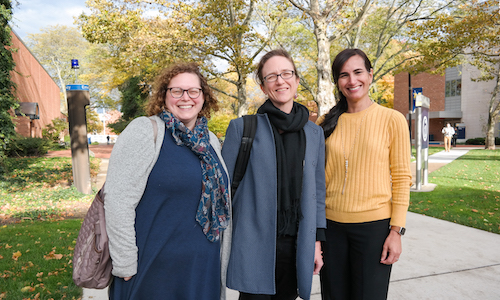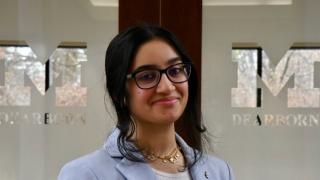With all kinds of promising innovations in teaching and educational technology, it’s easy to see why course redesigns are a big trend in higher ed. But what does it really take to “blow up your course,” as one of our UM-Dearborn professors put it? To fill out the picture, we chatted with three of our faculty who recently redesigned courses with support from The Hub’s Course Redesign Faculty Fellows Program. Here’s our conversation with COB Lecturer Mercedes Miranda, Women’s and Gender Studies Associate Professor Lisa Martin and Political Science Assistant Professor Emily Luxon, which has been lightly edited for length and clarity.
Reporter: So could each of you start by sharing why you wanted to do a redesign, and what you hoped to accomplish?
Mercedes: For me, the goal was to better present my course online. I’ve been teaching online for a long time, but I always felt like it was a one-way avenue. So I wanted to learn from the professional instructional designers at The Hub about how I could create more of a sense of community and interact more with my students. My second goal was to develop better assessment tools to track their comprehension. When you’re in a classroom, it’s much easier to get a feeling for how the students are progressing. But in the online environment, I always struggle with that, and I wanted to figure out ways to assess whether the online students were understanding the material.
Lisa: Well, I had never taught online, but a lot of the Women’s and Gender Studies courses are offered online. Our intro course was not, however, and we’d seen a lot of growth in enrollment for that class. We could keep offering more sections, but we thought making an online version would help support that enrollment even more. So I decided I’d try it. The challenge with that class is that it has a lot of ‘a-ha’ moments. And it’s the discussions and conversations that make the class so rich. So I was really curious to see how I could recreate that in an online format.
Emily: For me, part of the reason for the course redesign is that I kind of wanted to change everything about the class: I wanted to change the textbook, the assignment approach, stop having bluebook exams, and try out assignments that more meaningfully integrate student experiences with the class material. But I knew I was going to also teach an online version of the course in the winter. So I wanted to design it in a way that I could teach it both in-person and online and not have them feel like two completely different classes.
Reporter: And so how did you go about doing that?
Lisa: I think what’s great about The Hub is that there’s a structure to support you, but it’s also really flexible: I mean, you see how different each of our goals were. At the beginning, they really got us thinking with some big open-ended questions, and they also gave us readings on some key topics like, for example, assessments that don’t involve exams. We also each got assigned an instructional designer, and we had weekly meetings with them. We met once a month as a group, too, which was a great way to get feedback on your ideas from the group and learn from what everybody else was trying.
Emily: One of the things I found really useful about the group meetings is that we actually got to try out some of the tools, like Google Hangouts, that we might use in an online course. That really showed me the potential of the technology; or in some cases, it let me know why I might not want to use a particular tool.
Reporter: All the cool new instructional technology is definitely one of the things that makes this space so fun. What’s an example of a new idea — either a teaching method or a tech thing — that you found interesting or inspiring?
Emily: I remember I was reading an assigned blog post and I clicked through a couple links, and I found another post about someone who had their entire class write one research paper. I was really intrigued by that, so I decided to try it — not for this Hub redesign, but in a different class that I also redesigned. We’re still working our way through it, but the students have really stepped up. They’re organizing themselves, and coming up with ideas, and they’re doing things that are more active. Across all my classes, in fact, I’m trying to do more active learning and cut down on the amount of time I am lecturing at my students.
Lisa: For me, it was videos. And let me just say, Mercedes has to talk to you about how she does her videos, because they’re amazing. Eventually, though, as I explored the idea of video lectures, I ended up in a place that I thought I didn’t want to lecture much at all. So, for example, in another class, I’m doing kind of a flipped course. So if I am lecturing, I’ll throw the video up online. But then, in class, we’re doing many different kinds of group activities. I think that when students have the time to work together, they can do really impressive things. The challenge is we’re always giving them group projects and then making them find time outside of class, when they have such disparate schedules. But I know I have them all here twice a week, so why not use that time? Since I’ve been doing that, they’re suddenly not asking if they can work on their own, or trying to get out of the groups, which is what I’ve often experienced in the past.
Reporter: OK, Mercedes, let’s hear about those videos.
Mercedes: Well, I think I came to the realization that teaching online was a completely different animal than teaching in the classroom. What I was doing before working with The Hub is recording a video that was basically a PowerPoint with voiceover. And I thought if it was a three-hour class, I had to provide “entertainment” for three hours. But now, we know that doesn’t really work. So instead, I focus on highlights — the key points — and those videos are now just five minutes. I was very excited about this. In fact, I put a green screen in my basement so I could record all the videos, because it takes quite a bit of time to put them together. And now, I’m in the videos, talking in sync with the PowerPoint; so, for example, when I say “key point number one” it appears behind me on the screen. I thought the presence of someone in front of the camera really made a difference.
Reporter: Wow. That’s amazing that you built a studio in your basement! OK, one more question for everyone: How is it going so far? Or in the case that you’re teaching your redesigned course next semester, what’s something you’re looking forward to trying out?
Emily: Since I blew the class up and started from scratch, I feel like it’s still a little rough around the edges. For me, I’m usually not sure if I like something until I’ve done it. One of the things I’m doing this semester in the face-to-face class is giving students more time to talk or discuss, because my past classes told me I didn’t give them enough time on specific activities. But then, I did a mid-course evaluation in this class, and now apparently I’m giving them too much time! So I’m still trying to calibrate that. And with my lectures now, even in my other classes that haven’t been fully redesigned, I’ve started setting my phone timer for 10 minutes, and when it goes off, I’ll try to stop wherever I am and switch to doing an activity. That way the students are not getting hit with an hour straight of lecturing.
Lisa: So I’ll teach my online course for the first time in winter, and I think the big thing is that The Hub convinced me that I could get rid of exams and do different kinds of assessments. Instead, I’m doing lots of smaller lower-stakes assignments. For example, when they’re responding to discussion questions online, that will actually count for something. And they’ll have so many opportunities like this, no one thing will make or break them — like a big exam.
Mercedes: I actually taught my class this summer, but I’m still working to improve the videos. For example, I am using this feature Quizlet in a different course, and now the students watch the videos, and after two minutes, there is a question. That gives me the test of comprehension I was looking for. And like Lisa was saying, the students then have multiple, lower-stakes opportunities to earn points. So this time, I’m going to move away from the big test, where it’s 35 percent of their grade, and assign more weight to these quizzes. I don't know if the students will love me or hate me. But I think it helps motivate them. I guess we’ll find out.
###
Want to learn more about the The Hub’s Course Redesign Faculty Fellows Program? Or are you faculty and want to apply? You can find more details at the program website.




